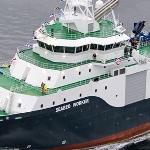Dyneema Makes Light Work Of Ultra-Deep Sea Recovery Operation
 A salvage operation on a ship wreck 3,200 m below the surface of the South Atlantic has been successfully carried out thanks to the use of lightweight ropes made with Dyneema ultra-high molecular weight polyethylene fibre. Dyneema fibre, manufactured by DSM, is used by Hampidjan to make Dynex Warp, an advanced patent-pending winch line for deep sea lifting and lowering as well as for towing fishing trawls.
A salvage operation on a ship wreck 3,200 m below the surface of the South Atlantic has been successfully carried out thanks to the use of lightweight ropes made with Dyneema ultra-high molecular weight polyethylene fibre. Dyneema fibre, manufactured by DSM, is used by Hampidjan to make Dynex Warp, an advanced patent-pending winch line for deep sea lifting and lowering as well as for towing fishing trawls.
The Dynex Warp rope was used over several months on the vessel Seabed Worker in a salvage operation to rescue valuable cargo from a sunken ship. The depth of the wreck meant that use of steel rope would have been virtually impossible, since it would have had a weight in the water of over 35 t. By contrast, the Dynex Warp rope containing Dyneema fibre weighed a mere 740 kg, thanks to its relative density of 1.1. Out of the water, 4.2 km of the Dynex Warp rope weighs 6.5 t, against around 50 tonnes for the same length of steel rope with the same strength.
Rope
The version of Dynex Warp used in this operation is a 12-strand braided rope with a diameter of 46 mm. It has the same strength as a steel rope with the same diameter. Even pulling up heavy loads from over 3 km below, it shows very little elongation. The rope consists of six different layers that together provide very high cross-sectional stability and axial stiffness.
This reduced weight affects not only the lifting operation but also the stability of the vessel and its deck load capacity. In fact, the Seabed Worker holds a 6,000m Dynex Warp rope for future operations, without needing to switch to a larger winch which would require a larger and thus more expensive vessel. The ship is operated by the Norwegian Seabed Group, a long-established company equipped with ultra-modern equipment for deep-sea operations including wreck salvage. Seabed says that over the several months it has been using the Dynex Warp rope for the current operation, on a standard drum winch with an electronically controlled spooling system, it has experienced no problems at all with the spooling, even though the rope has a high number of layers on the drum.






